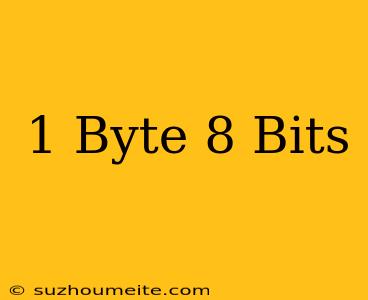1 Byte = 8 Bits: Understanding the Basics of Digital Data
In the world of digital technology, data is represented using a binary system consisting of 0s and 1s. These binary digits, or bits, are the fundamental units of digital information. But have you ever wondered how these bits are grouped together to form larger units of data? In this article, we'll explore the relationship between bytes and bits, and why 1 byte is equal to 8 bits.
What is a Bit?
A bit is the smallest unit of digital information. It can have only two values: 0 or 1. These values are often represented using binary numbers, where 0 represents a low voltage signal and 1 represents a high voltage signal. Bits are used to represent simple on/off or true/false values in digital systems.
What is a Byte?
A byte is a group of bits that are used together to represent a single unit of digital information. The number of bits in a byte can vary depending on the system, but in modern computing, a byte is typically composed of 8 bits. This group of 8 bits is used to represent a single character, number, or other unit of data.
Why 1 Byte = 8 Bits
So, why do we use 8 bits to form a byte? The reason lies in the history of computing. In the early days of computing, computers used a variety of byte sizes, ranging from 6 to 12 bits. However, the 8-bit byte became the standard due to its flexibility and efficiency.
Using 8 bits allows for a total of 2^8 (256) possible unique combinations of 0s and 1s. This is sufficient for representing a wide range of characters, numbers, and symbols, making it an ideal size for most digital applications.
Advantages of 8-Bit Bytes
The 8-bit byte has several advantages that have contributed to its widespread adoption:
- Efficient: 8 bits provide a good balance between data storage and processing efficiency.
- Flexible: 8-bit bytes can represent a wide range of data types, including characters, numbers, and symbols.
- Universal: The 8-bit byte has become a standard in modern computing, making it easy to share and process data across different systems.
Conclusion
In conclusion, the relationship between bytes and bits is fundamental to understanding digital data. The 8-bit byte has become the standard unit of digital information due to its efficiency, flexibility, and universality. By understanding why 1 byte is equal to 8 bits, we can appreciate the complexity and beauty of digital technology.
